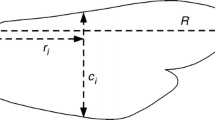Summary
In the Hawaiian species, Drosophila mimica, it was necessary to determine the dispersal pattern in order to interpret genetic heterogeneity observed in the population. In addition, the pattern of colonization and speciation in the Drosophila community may have been affected by the dispersal behavior and response to infrequent conditions of environmental factors which would encourage sporadic movement. It was not possible in this experiment to measure such behavior directly, but predictions are possible.
Dispersal patterns are formulated in terms of component behavioral responses to particular environmental cues. Under appropriate field measurements, the relationship of behavior patterns of D. mimica to air movement, light, humidity, and food substrate were sufficient to interpret a complex dispersal pattern in the field. Predictions were made for other movement patterns over longer distances and with infrequent occurrence.
Present results are explainable by the response of D. mimica to low velocity air currents. Flies move into the current at velocities less than about 3.3 km/hr, and this response is consistent with field observations of insect and air movements. Visible light intensities from more than 10 to about 100 lux were most acceptable to this species, and movement was restricted to light periods.
Based upon responses of D. mimica to wind, light, humidity, and attractive areas, long range dispersal would likely occur between two habitats when each had suitable food substrates, the weather was very humid, overcast, and when there was a slight air current between the habitats. Movement would be unidirectional only if air current patterns were stable. The most precise navigation would be at air current velocities below 3.3 km/hr, where olfactory orientation on the substrate in the new habitat would be possible and short flights would be upwind. However, longer range movements would be possible downwind at slightly higher velocities.
Genetic data on D. mimica has been interpreted to reflect differences in selection between at least moderately isolated habitats. Our results indicate that, instead of isolated populations, these habitats contain populations that are part of a single deme with sporadic mixing. Genetic heterogeneity may temporarily result from intense localized selection pressure between periods of mixing.
Furthermore, the presence of several sibling species (some undescribed) in Kipuka Puaulu and in several neighboring areas clearly illustrates the fragmentation of gene pools and the genetic differentiation which is possible. Since D. mimica might move from one kipuka to another, spatial isolation is unlikely to play a major role in speciation, whereas habitat selection and ethological isolation may be the principal mechanisms of speciation.
Similar content being viewed by others
References
Dingle, H.: Migration strategies of insects. Science 175, 1327–1335 (1972)
Dobzhansky, Th.: Active dispersal and passive transport in Drosophila. Evolution 27, 565–575 (1973)
Dobzhansky, T., Wright, S.: Genetics of natural populations. X. Dispersion rates in Drosophila pseudoobscura. Genetics 28, 304–340 (1943)
Hardy, D. E.: Insects of Hawaii, vol. 12, Diptera: Cyclorrhapa II. Series Shizophora, Sect. Acalypterae I, Family Drosophilidae, pp. 314: Honolulu: University of Hawaii Press 1965
Heed, W. B.: Ecology of Hawaiian Drosophilidae. Studies in genetics IV, M. R. Wheeler, ed., University of Texas, Publ. No. 6818, p. 387–419 (1968)
Heed, W. B.: Host plant specificity and speciation in Hawaiian Drosophila. Taxon 20, 115–121 (1971)
Johnson, C. G.: Migration and dispersal of insects by flight, pp. 763. London: Methuen 1969
Johnston, J. S.: Dispersal in desert-adapted Drosophila. Ph. D. Dissertation, University of Arizona, Tucson (1972)
Kellogg, F. E., Frizel, D. E., Wright, R. H.: The olfactory guidance of flying insects. IV. Drosophila. Canad. Ent. 94, 884–888 (1962)
Richardson, R. H.: Migration and isozyme polymorphisms in natural populations of Drosophila. Jap. J. Genet., Suppl. 1, 172–179 (1969)
Richardson, R. H.: Models and analyses of dispersal patterns. In: Mathematical topics in genetics, K. Kojima, ed., p. 79–103. Berlin: Springer 1970
Richardson, R. H.: Effects of dispersal, habitat selection and competition on a speciation pattern of Drosophila endemic to Hawaii. In: Genetic mechanisms of speciation in insects, M. J. D. White, ed., p. 140–164. Sydney: Australia and New Zealand Book 1974
Richardson, R. H., Johnston, J. S.: Ecological specialization of Hawaiian Drosophila. Habitat selection in Kipuka Puaulu. Oecologia (in press, 1975)
Richardson, R. H., Wallace, R. J., Jr., Gage, S. J., Bouchey, G. D., Denell, M.: Neutron activation analysis techniques for labeling Drosophila in natural populations. In: Studies in genetics, vol. V, M. R. Wheeler, ed., University of Texas, Publ. No. 6918, p. 171–186 (1969)
Rockwood, E. S.: Enzyme variation in natural populations of Drosophila mimica. In: Studies in genetics, vol. V, M. R. Wheeler, ed., University of Texas, Publ. No. 6918, p. 111–132 (1969)
Smathers, G. A.: A report on the microclimates of two Hawaiian kipukas (in support of HAVO-N-8). Hawaii Volcanoes National Park (mimeograph) (1968)
Wallace, B.: On the dispersal of Drosophila. Amer. Natur. 100, 551–563 (1966)
Wallace, B.: Observations on the microdispersion of Drosophila melanogaster. In: Essays in evolution and genetics in honor of Theodosius Dobzhansky. Suppl. to Evolutionary biology, p. 381–399. New York: Appleton-Century-Crofts 1970
Wright, S: Dispersion of Drosophila pseudoobscura. Amer. Natur. 102, 81–84 (1968)
Author information
Authors and Affiliations
Additional information
Supported primarily by USAEC Contract AT-(40-1)-4023, secondarily by NIH Grant GM 11609, an NSF Grant to D. E. Hardy, NSF Grants GB 7252 and GB 22770.
NIH Career Development Award 5K04-GM 47350.
Postdoctoral Trainee, NIH Training Grant 5 T01 GM 00337
Rights and permissions
About this article
Cite this article
Richardson, R.H., Johnston, J.S. Behavioral components of dispersal in Drosophila mimica . Oecologia 20, 287–299 (1975). https://doi.org/10.1007/BF00345519
Received:
Issue Date:
DOI: https://doi.org/10.1007/BF00345519




